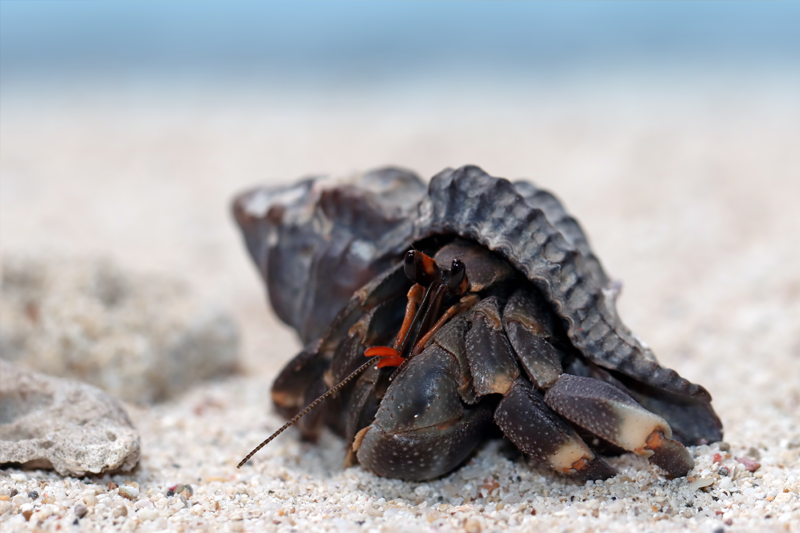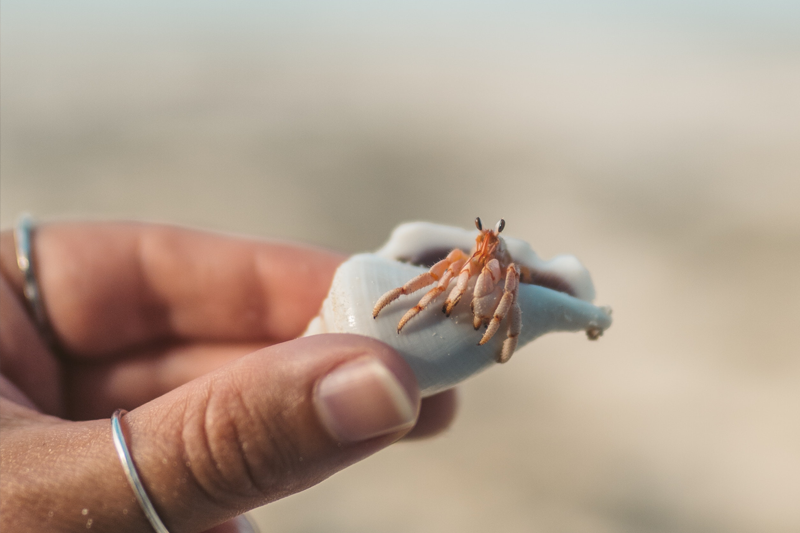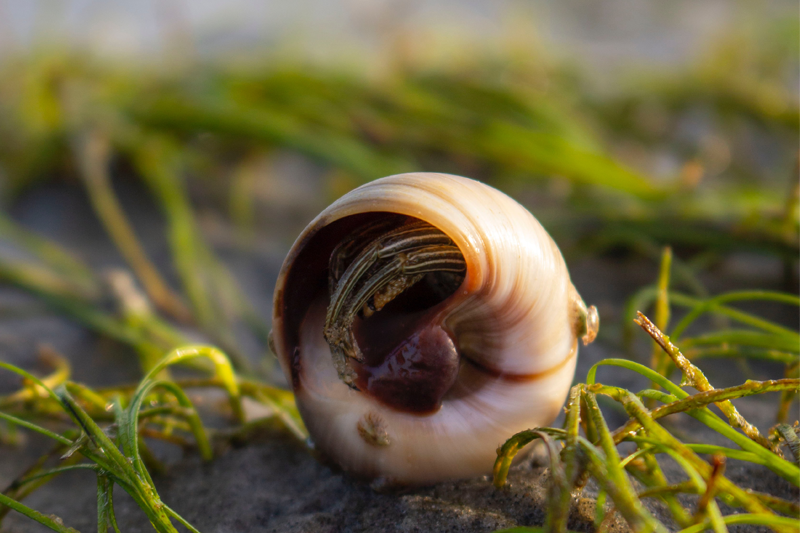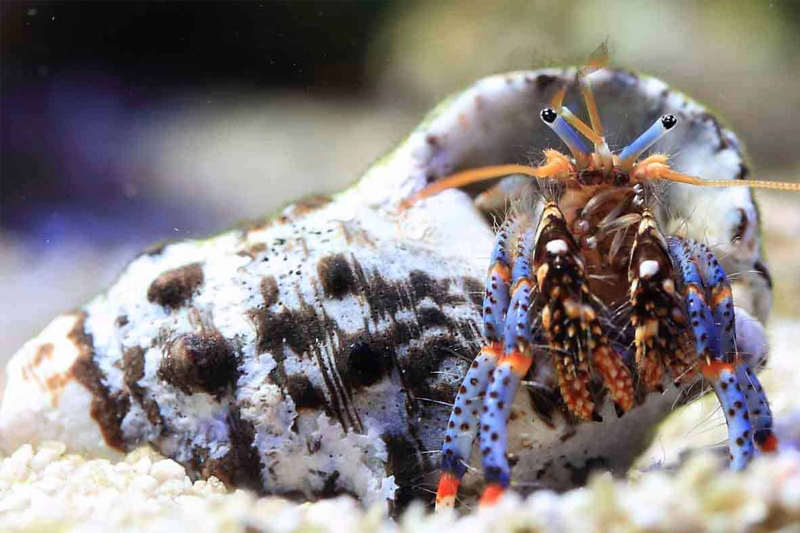You just got your first hermit crab and don’t know the in’s and out’s of taking care of them in terms of shelter, feeding, health and care, and more. So in this article we will be providing a comprehensive care guide that you can use as a reference.
Few basic tips for caring for a hermit crab:
- Housing: Hermit crabs need a suitable habitat to thrive. A glass aquarium or terrarium with a tight-fitting lid is a good option. The enclosure should be filled with substrate (such as coconut fiber) to a depth of at least 3 inches to allow for burrowing. Provide a shallow dish of fresh water for drinking and a separate dish for saltwater for bathing.
- Temperature and humidity: Hermit crabs are tropical creatures and need a warm, humid environment to stay healthy. Keep the temperature in the enclosure between 75-85 degrees Fahrenheit, and maintain humidity levels of 70-80% by misting the substrate with water regularly.
- Diet: Hermit crabs are omnivorous and will eat a variety of foods, including fresh fruits and vegetables, protein sources (such as cooked chicken or fish), and commercial hermit crab food. Offer a variety of foods to ensure a balanced diet.
- Molting: Hermit crabs shed their exoskeletons (a process called molting) as they grow. During this time, they will need a quiet, dark space to rest and recover. Avoid handling or disturbing your crab during this time.
- Socialization: Hermit crabs are social creatures and do best when kept in groups of at least two. Make sure your enclosure is large enough to accommodate multiple crabs, and provide plenty of hiding places and climbing structures.
- General care: Keep the enclosure clean by removing uneaten food and feces regularly. Monitor your hermit crab for signs of illness, such as lethargy, loss of appetite, or unusual behavior. If you notice any of these symptoms, consult with a veterinarian who has experience treating hermit crabs.
Quick Facts About Hermit Crabs
- Hermit crabs are not true crabs, but rather are members of the infraorder Anomura, which also includes squat lobsters and porcelain crabs.
- There are over 800 species of hermit crabs, ranging in size from less than half an inch to over 16 inches.
- Hermit crabs are found in oceans all over the world, from shallow tidal pools to deep-sea trenches.
- Hermit crabs have soft abdomens and protect themselves by finding and occupying empty seashells or other protective structures.
- Hermit crabs can live for up to 30 years in the wild, but their lifespan is generally shorter in captivity.
What should you take note of their enclosure?
When setting up an enclosure for your hermit crab, there are a few things you should take note of to ensure that your crab is happy and healthy. Here are some important considerations:
- Size: Hermit crabs need a large enough enclosure to accommodate their needs. A general rule of thumb is to provide at least 5 gallons of space per crab. So, for example, two hermit crabs would require a minimum of a 10-gallon tank.
- Substrate: Hermit crabs need a substrate that is deep enough to allow them to burrow. A depth of at least 3 inches is recommended. A good substrate is coconut fiber, which provides moisture and helps maintain humidity levels.
- Humidity: Hermit crabs require a humid environment to thrive. Ideally, the humidity level should be between 70-80%. This can be achieved by misting the substrate regularly and providing a shallow dish of fresh water for drinking and a separate dish of saltwater for bathing.
- Temperature: Hermit crabs are tropical animals and require a warm environment. The temperature in the enclosure should be maintained between 75-85 degrees Fahrenheit.
- Hiding places: Hermit crabs are shy creatures and need plenty of hiding places to feel secure. Provide plenty of rocks, branches, and other structures for climbing and hiding.
- Lighting: Hermit crabs require a natural light cycle, which can be achieved with a low-wattage bulb or by placing the enclosure near a window that receives indirect sunlight.
- Cleanliness: Hermit crabs are sensitive to ammonia, which is produced by their own waste. It is important to clean the enclosure regularly and remove uneaten food and feces promptly.
- Socialization: Hermit crabs are social creatures and do best when kept in groups of at least two. Make sure the enclosure is large enough to accommodate multiple crabs and provide plenty of hiding places and climbing structures.
How about food and water bowls? Are they necessary?
Providing the appropriate food and water dishes for your hermit crab is important for its overall health and wellbeing. Here are some things to consider when selecting food and water bowls for your hermit crab enclosure:
- Size: The size of the bowls should be appropriate for your hermit crab. The bowls should be large enough for your crab to drink or eat from comfortably, but not so large that they take up too much space in the enclosure.
- Depth: The depth of the bowls is also important. The water dish should be shallow enough for your hermit crab to climb in and out of easily, but deep enough to provide access to fresh water. The food dish should be shallow enough for your crab to reach the food, but not so deep that they have difficulty accessing it.
- Material: The bowls should be made of a safe, non-toxic material. Ceramic, glass, or plastic dishes are all suitable options.
- Placement: The bowls should be placed in a location that is easily accessible to your hermit crab. They should be kept away from areas where your crab likes to burrow or climb.
- Cleaning: The bowls should be cleaned regularly to prevent the growth of bacteria and other harmful microorganisms. You can clean the bowls with hot water and a mild soap, or by using a pet-safe disinfectant.
When it comes to providing water for your hermit crab, it is important to provide both fresh water and saltwater. The freshwater bowl should be filled with dechlorinated water (such as bottled or filtered water) and should be changed daily. The saltwater bowl should contain a mix of aquarium salt and freshwater. The ratio of salt to water should be about 1 tablespoon of salt per gallon of water. The saltwater bowl should also be changed daily to ensure that it remains fresh and clean.
What can and cannot they eat?
Hermit crabs are omnivorous and eat a variety of foods. However, there are some foods that are safe and healthy for them to eat, and some that should be avoided. Here are some guidelines for what hermit crabs can and cannot eat:
Foods that are safe for hermit crabs:
- Commercial hermit crab food: High-quality commercial hermit crab food is a good source of nutrition for your hermit crab. Make sure to read the label and choose a food that is high in protein and free from preservatives, artificial colors, and flavors.
- Fresh fruits and vegetables: Hermit crabs can eat a variety of fresh fruits and vegetables, such as apples, bananas, grapes, carrots, and broccoli. These should be washed and chopped into small pieces before being offered to your crab.
- Protein sources: Hermit crabs need protein to maintain their health. Good sources of protein include cooked chicken, fish, and shrimp, as well as boiled eggs and tofu.
- Calcium sources: Hermit crabs need calcium to maintain their exoskeletons. Good sources of calcium include cuttlebone (available at pet stores), crushed eggshells, and crushed oyster shells.
Foods that should be avoided:
- Processed foods: Processed foods, such as chips, crackers, and sweets, are high in salt and sugar and should be avoided.
- Spicy foods: Hermit crabs are sensitive to spicy foods and should not be fed spicy or hot foods.
- Citrus fruits: Citrus fruits, such as oranges and lemons, are acidic and can cause digestive problems for hermit crabs.
- Dairy products: Hermit crabs are lactose intolerant and should not be fed dairy products.
- Raw meat: Raw meat can contain harmful bacteria that can make your hermit crab sick. All protein sources should be cooked before being offered to your crab.
Remember to always provide fresh food and remove any uneaten food from the enclosure after a few hours to prevent spoilage and the growth of harmful bacteria.
Handling & Safety
While hermit crabs can be fascinating pets to observe, they are not generally recommended as pets that should be handled frequently. Hermit crabs are not social animals and can become stressed or injured if handled too often or too roughly. Here are some guidelines to follow when handling your hermit crab:
- Approach slowly and gently: If you do need to handle your hermit crab, approach slowly and gently. Avoid sudden movements or loud noises that can startle or frighten your crab.
- Hold with both hands: When handling your hermit crab, use both hands to support its body. Cup your hands around the shell, being careful not to squeeze too tightly.
- Avoid grabbing by the claws: Never pick up your hermit crab by its claws, as this can cause damage to its delicate limbs.
- Keep the crab low to the ground: If your hermit crab does fall or jump out of your hands, it is important to keep it low to the ground to prevent injury. A fall from even a short distance can cause serious harm to your hermit crab.
- Watch for signs of stress: Hermit crabs are easily stressed, so watch for signs that your crab is uncomfortable, such as hiding in its shell, pinching or moving away from your hands, or making clicking or chirping sounds.
In addition to handling guidelines, it is important to take safety precautions when caring for your hermit crab. Here are some tips to keep in mind:
- Wash your hands: Always wash your hands before and after handling your hermit crab or cleaning its enclosure to prevent the spread of germs.
- Avoid chemicals: Avoid using any cleaning products or chemicals in or near your hermit crab’s enclosure, as these can be harmful to your crab.
- Check the temperature: Hermit crabs are sensitive to temperature changes, so make sure that the temperature in their enclosure remains consistent and within their preferred range.
- Use safe substrate: Use a safe substrate in your hermit crab’s enclosure, such as coconut fiber or sand, and avoid using any substrates that could be harmful if ingested.
By following these guidelines, you can ensure that your hermit crab is safe and comfortable in its environment.
Does your hermit crabs needs toys to get entertained and for activity?
While hermit crabs don’t necessarily need accessories to stay healthy, providing them with a variety of accessories and toys can help keep them entertained and stimulated. Here are some examples of accessories and toys that you can provide for your hermit crab:
- Climbing structures: Hermit crabs are natural climbers and will appreciate having a variety of structures to climb on. You can provide them with natural branches, rocks, or other objects that they can climb on.
- Hiding places: Hermit crabs like to hide and will appreciate having a variety of hiding places in their enclosure. You can provide them with small caves or tunnels made from coconut shells or PVC pipes.
- Toys: Hermit crabs enjoy playing with toys, such as small plastic balls or puzzle feeders. You can also provide them with small mirrors or objects with interesting textures.
- Water dishes: Hermit crabs require both freshwater and saltwater dishes in their enclosure. Providing them with shallow dishes that they can soak in or climb on can help keep them entertained and stimulated.
- Decorations: Adding decorations to your hermit crab’s enclosure can also help keep them entertained. You can add natural or artificial plants, shells, or other decorations to create a visually appealing environment.
It is important to remember that hermit crabs are sensitive to changes in their environment and can become stressed if their habitat is disturbed too often. When adding new accessories or toys to their enclosure, do so gradually and monitor their behavior to ensure that they are comfortable and not feeling stressed.





